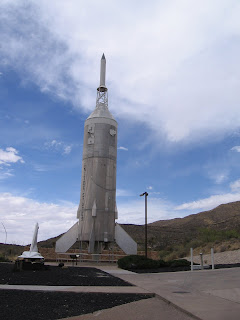 The Dunn Solar Telescope
The Dunn Solar Telescope Inside the Dunn Telescope.
Inside the Dunn Telescope. Horned lizard along the rail trail.
Horned lizard along the rail trail. Rocket Garden
Rocket Garden Jim trying to land the shuttle. I crashed three times.
Jim trying to land the shuttle. I crashed three times. Plaque honoring Joe Walker.
Plaque honoring Joe Walker. Chuck talks about life in space.
Chuck talks about life in space. An actual Sputnik.
An actual Sputnik. Model of the Trinity atomic bomb site.
Model of the Trinity atomic bomb site.For most of the drive from El Paso to Alamogordo we could see a large white tower up in the Sacramento Mountains. It turned out to be the top of a huge solar telescope at the National Solar Observatory in Sunspot, NM. We toured the observatory which has several telescopes and offers great views into the Tularosa Basin. We were allowed to go into the building housing the Dunn Telescope (the one we had seen on the drive) which towers 136 feet into the sky and goes down into the ground 228 feet. We talked to the astronomers who were working and could see the spectrum of the sun they were viewing. They explained what it all meant, but it was as far over our heads as the sun. Each of the several telescopes studies different parts of the sun including one set up to monitor solar activity by automatically taking pictures every minute. They still have the first telescope dome from 1950, a modified grain bin they ordered from the Sears catalog. The visitors center has several exhibits about the sun and the work of the observatory. It was neat to be able to get into the buildings and talk first hand with the scientists.
We hiked part of the Cloud-Climbing Rail Trail that follows the rail bed of the old Alamogordo & Sacramento Mountain Railway. It was built to bring timber down from the mountains. The railway climbed 4000 feet in 26 miles clinging to cliffs, using switchbacks for sections to tight for turns and trestles to cross canyons. Only a few trestles still exist. The railway helped the growth of Cloudcroft as a resort community by offering excursions. The trail allows for easy hiking along the old right-of-way through the surrounding forest.
Another local attraction we visited was the New Mexico Museum of Space History which celebrates New Mexico's role in the development of rockets and space exploration. The museum has an International Space Hall of Fame honoring those from around the world who have made contributions. Among the honorees is Joe Walker from Washington County, PA who piloted the X-15 at speeds over 4000 MPH and up to 350,000 feet. Exhibits provide information on different satellites, rockets and space programs with an emphasis on programs developed in New Mexico. There is an outdoor space park where larger rockets are displayed. We attended a program on the effects of space flight on humans given by Chuck, a volunteer who had been a back up on several flights but never got to go into space but had completed several flights in NASA's "vomit comet," a plane which is used to simulate weightlessness. He had lived in the same neighborhood and was friends with several astronauts including the original seven and Jim Lovell the commander of Apollo 13. For someone like me who got up in the middle of the night to see Sputnik pass overhead in 1958 it was neat to see one of the actual satellites on display.
We really enjoyed our time in Alamogordo and plan on returning in the future to visit other sites in the area. One thing we missed by a day was the chance to go to the Trinity Site, the place where the first atomic bomb was exploded in 1945. It is only open to the public two days a year and we missed the April visit by a day. Oh well, we find we never get to do everything we would like to at each stop and this gives us a reason to keep travelling so we can return in the future.



No comments:
Post a Comment